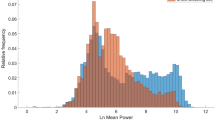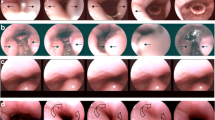Abstract
Purpose
Catathrenia (nocturnal groaning) is a rare and relatively little-understood parasomnia. The characteristics of the sound and the recordings are not similar in all the relevant research papers. Indeed, there is currently some discussion regarding whether or not this is a single entity. For some authors, catathrenia is a particular form of parasomnia; for others, it may be a variant of snoring or a respiratory problem. The goal is to establish whether or not catathrenia may be regarded as an expiratory vocal sound. An attempt was made to classify the origin of this sound according to its sound structure.
Methods
We present the sound analysis of two patients, a man and a woman, with clinically diagnosed catathrenia and we compared them with the analysis of snoring. We use the spectrogram and the oscillogram. We classified the sounds according to the Yanagihara criteria.
Results
The vocal nature of the sound was confirmed, and several significant differences to some snoring sounds were discovered. The analysis of the catathrenia samples demonstrated that these signals are type II according to Yanagihara classification; these signals had a very short jitter, and had formants and harmonics. However, snoring is a type III, very irregular and had formants but not harmonics.
Conclusions
The oscillogram and the spectrogram in these patients show that the origins of the sounds are clearly different: catathrenia is laryngeal, while snoring is guttural. Catathrenia cannot be considered as expiratory snoring.



Similar content being viewed by others
References
De Roek J, Van Hoof E, Cluydts R (2003) Sleep-related expiratory groaning. A case report. J Sleep Res 12:237
AASM (2005) The International Classification of Sleep Disorders. Revised and coding manual, 2nd edn. AASM, Westchester
Vetrugno R, Provini F, Plazzi G, Vignatelli L, Lugaresi E, Montagna P (2001) Catathrenia (nocturnal groaning): a new type of parasomnia. Neurology 56:681–683
Guilleminault C, Hagen CC, Khaja AM (2008) Catathrenia: parasomnia or uncommon feature of sleep disordered breathing? Sleep 31:132–139
Songu M, Yilmaz H, Yuceturk AV, Gunhan K, Ince A, Bayturan O (2008) Effect of CPAP therapy on catathrenia and OSA: a case report and review of the literature. Sleep Breath 12:401–405
Ramar K, Gay P (2008) Catathrenia: getting the ‘cat’ out of the bag. Sleep Breath 12:291–294
Oldani A, Manconi M, Zucconi M, Castronovo V, Ferini-Strambi L (2005) ‘Nocturnal groaning’: just a sound or parasomnia? J Sleep Res 14:305–310
Guilleminault C, Hagen CC, Khaja AM (2008) Catathrenia is not expiratory snoring. Sleep 31:774–775
Ramar K, Olson EJ, Morgenthaler TI (2008) Catathrenia. Sleep Med 9:457–459
Vetrugno R, Lugaresi E, Plazzi G, Provini F, D’Angelo R, Montagna P (2007) Catathrenia (nocturnal groaning): an abnormal respiratory pattern during sleep. Eur J Neurol 14:1236–1243
Manconi M, Zucconi M, Carrot B, Ferri R, Oldani A, Ferini-Strambi L (2008) Association between bruxism and nocturnal groaning. Mov Disord 23:737–739
Vetrugno R, Lugaresi E, Ferini-Strambi L, Montagna P (2008) Catathrenia (nocturnal groaning): what is it? Sleep 31:308–309
Siddiqui F, Walters AS, Chokroverty S (2008) Catathrenia: a rare parasomnia which may mimic central sleep apnea on polysomnogram. Sleep Med 9:460–461
Pevernagie DA, Boon PA, Mariman AN, Verhaeghen DB, Pauwels RA (2001) Vocalization during episodes of prolonged expiration: a parasomnia related to REM sleep. Sleep Med 2:19–30
Ortega-Albas JJ, Diaz JR, Serrano AL, de Entrambasaguas M (2006) Continuous positive airway pressure as treatment for catathrenia (nocturnal groaning). Neurology 67:1103
Iriarte J, Alegre M, Urrestarazu E, Viteri C, Arcocha J, Artieda J (2006) Continuous positive airway pressure as treatment for catathrenia (nocturnal groaning). Neurology 66:609–610
Abbasi A, Morgenthaler T, Olson EJ et al (2008) Catathrenia: a North American experience. Sleep 31:A263
Cohen A (1990) Signal processing methods for upper airway and pulmonary dysfunction diagnosis. IEEE Eng Med Biol Mag 9:72–75
Hara H, Murakami N, Miyauchi Y, Yamashita H (2006) Acoustic analysis of snoring sounds by a multidimensional voice program. Laryngoscope 116:379–381
Yanagihara N (1967) Significance of harmonic changes and noise components in hoarseness. J Speech Hear Res 10:531–541
Pevernagie D, Aarts RM, De Meyer M (2009) The acoustics of snoring. Sleep Med Rev 14:131–144
Herzog M, Schmidt A, Bremert T, Herzog B, Hosemann W, Kaftan H (2008) Analysed snoring sounds correlate to obstructive sleep disordered breathing. Eur Arch Otorhinolaryngol 265:105–113
Agrawal S, Stone P, McGuinness K, Morris J, Camilleri AE (2002) Sound frequency analysis and the site of snoring in natural and induced sleep. Clin Otolaryngol Allied Sci 27:162–166
Fiz JA, Abad J, Jane R, Riera M, Mananas MA, Caminal P, Rodenstein D, Morera J (1996) Acoustic analysis of snoring sound in patients with simple snoring and obstructive sleep apnoea. Eur Respir J 9:2365–2370
Perez-Padilla JR, Slawinski E, Difrancesco LM, Feige RR, Remmers JE, Whitelaw WA (1993) Characteristics of the snoring noise in patients with and without occlusive sleep apnea. Am Rev Respir Dis 147:635–644
Quinn SJ, Huang L, Ellis PD, Williams JE (1996) The differentiation of snoring mechanisms using sound analysis. Clin Otolaryngol Allied Sci 21:119–123
Disclosure of Conflicts of Interest
None of the authors has any conflict of interest to disclose.
Author information
Authors and Affiliations
Corresponding author
Rights and permissions
About this article
Cite this article
Iriarte, J., Fernández, S., Fernandez-Arrechea, N. et al. Sound analysis of catathrenia: a vocal expiratory sound. Sleep Breath 15, 229–235 (2011). https://doi.org/10.1007/s11325-010-0420-x
Received:
Revised:
Accepted:
Published:
Issue Date:
DOI: https://doi.org/10.1007/s11325-010-0420-x




